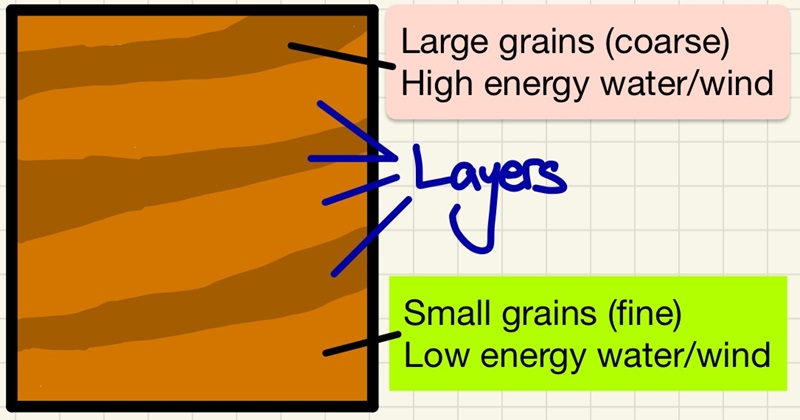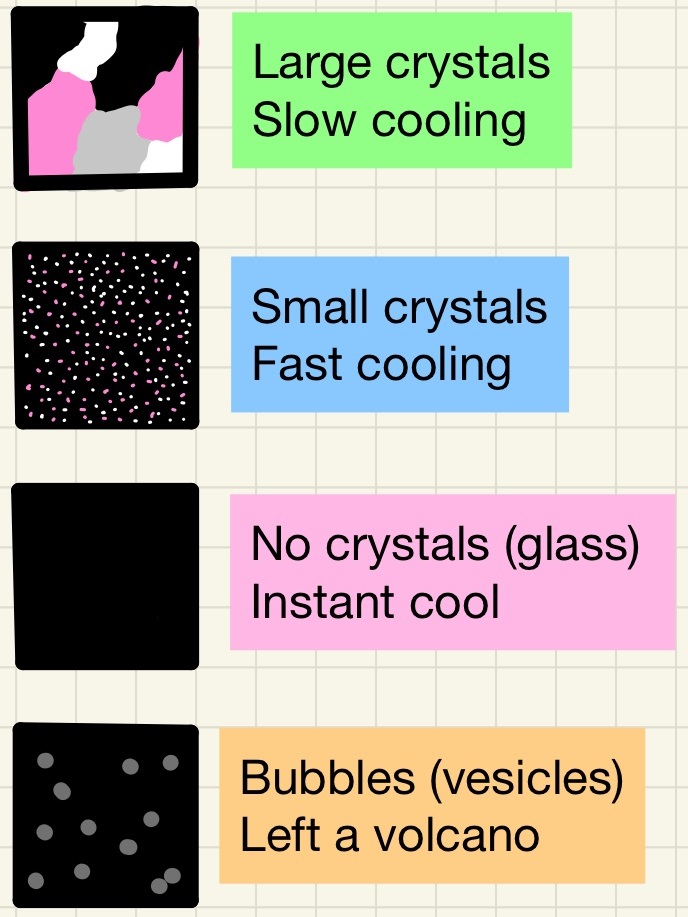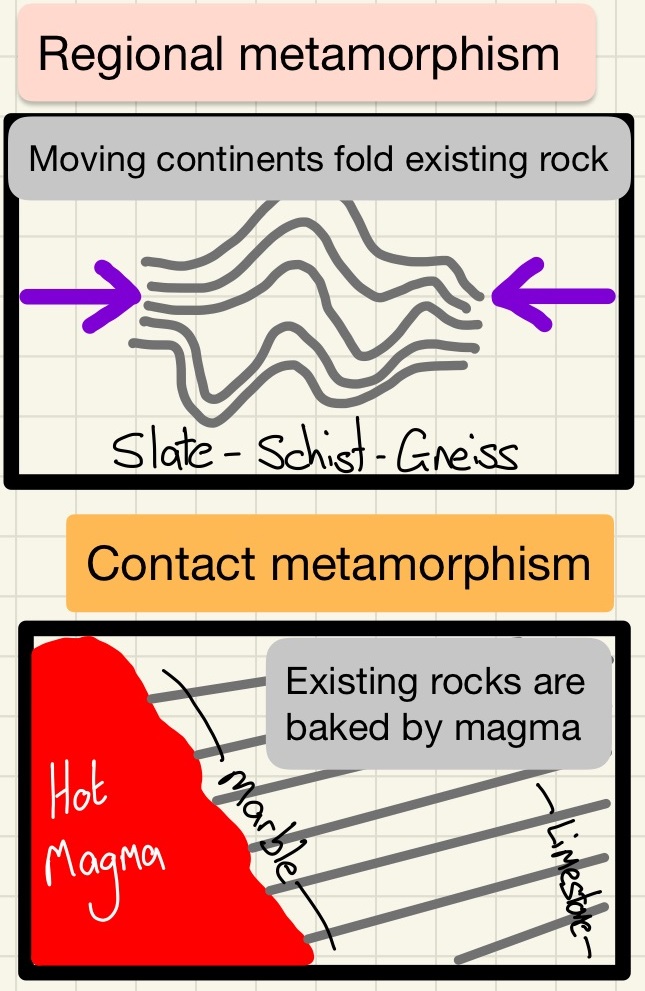Key Stage 3 Earth Science
What we are learning:
The structure of the Earth:

Here you learn about the layers that make up Earth. As well as the inner core, outer core, mantle and crust, you need to know a little about their properties. Don't forget the hydrosphere and the atmosphere too! Now that we have that knowledge in place, look carefully at how we know these facts. Nobody has been into the mantle or swam around in the outer core, so how do we know their properties? From the Kola Superdeep Borehole in Russia, to earthquakes and rocks that are ejected from volcanoes, scientists have put these fragments of evidence together to make our current theory. Remember that theories evolve as new evidence is gathered.
Sedimentary Rocks:

The first rock type that we see is the Sedimentary rock. Once you recognise them you will spot them in road cuttings, outcrops and small rocks and pebbles in rivers, streams and at the beach. Sedimentary rocks have layers and are made from grains, some rains are large and some as so small that you need a microscope to see them. Sedimentary rocks form in a process that involved breaking apart an existing rock and moving it to a new place and making a new rock.
Weathering/erosion, transportation, deposition, compaction & cementation.
Igneous Rocks:

Igneous rocks are often the most exciting as they make us think about volcanoes and disaster movies. This is true, some igneous rocks come from volcanoes, but not all. Igneous rocks are made from crystals that are interlocking. Their crystal size varies and this tells us lots about how they were formed. Igneous rocks have lots of carbon dioxide dissolved in them when they are melted (remember this for future lessons). When magma (liquid rock below the surface) reaches the surface, it becomes lava. If the lava touches the air, the carbon dioxide bubbles out as the pressure is released (just like when you take the lid off a pop bottle) which will give the rock lots of little holes. If the lava cools quickly, it will have little crystals, if it touches water and cools very very quickly, it will have no crystals so becomes a glass like obsidian. Some magma never gets to the surface and cools very slowly over hundreds of years or longer, these samples will have very large crystals. Today, we can use the size of crystals and the presence or absence of gas bubbles to tell a lot about the environment in which the rock formed.
Metamorphic rocks:

The final type of rock is the metamorphic rock. This is simply an existing rock (sedimentary or igneous) that has been changed by an outside process. The first is contact metamorphism in which a chamber of magma is formed next to existing rocks and the heat literally bakes it. The second is regional metamorphism, this is when plates are moving nearby and huge amounts of pressure crush, twist, lift or bury existing rock and cause it to be changed.
The Rock Cycle:

You have already met parts of the rock cycle and here we will put them all together. We need to look in detail at weathering which is the physical break up and chemical breakdown of rock and erosion which is the transportation of solid rock particles (never get these two mixed up). They are linked to transportation, deposition, compaction and cementation as we saw when we looked at sedimentary rocks. We can link these to subduction through plate movement, partial melting and formation of fresh igneous rocks. Don't forget that when there is subduction and magma, there will also be regional and contact metamorphism. Think of this a rock recycling!
Earth as a finite resource:

It is very important that every student is a global citizen and we must all be aware of the resources of our planet and what is available for us and to ensure that there will be plenty for future generations. Here we can investigate the resources that we use such as crude oil, coal, gas, metals and rocks. Are these finite? Is there plenty? What do we use them all for? Are there alternatives? How can we change to ensure that our grandchildren will have plenty too?
Recycling, Biofuels and the Carbon Cycle:

Recycling is fairly obvious but we as a society do not do this enough, it is easier to throw away things and to buy new. Biofuels are a great way to replace crude oil as a fuel source. Growing crops to extract the oil and create alternatives to diesel is not only good as we won't run out, it is also carbon neutral meaning that the amount of carbon released when the fuel is burned is the same as the amount of carbon the plant absorbed through photosynthesis. This brings us nicely to the carbon cycle which shows us how carbon gets into the atmosphere and how it is removed from the atmosphere. The most important thing to note is the precarious balance, there are many more ways of getting carbon into the atmosphere than there are of getting it out again.
Our atmosphere:

Our atmosphere is 78% Nitrogen, 21% Oxygen and 0.04% Carbon Dioxide. It has not always had this composition and we will look at how it has changed over time. We believe that the atmosphere was mainly carbon dioxide and water vapour when the Earth first formed. This slowly evolved into today's atmosphere over 4 billion years with processes including cooling, photosynthesis and geological processes like volcanoes.
Human impact on climate change:

We can link some of our previous lessons together to help to predict the future climate, see human impact on climate changes and suggest ways of reducing that impact. We begin by looking at the carbon dioxide levels in our atmosphere over the past 300 years and how the industrial revolution, population growth and our thirst for resources and energy has increased the amount of atmospheric carbon dioxide. By looking at the carbon cycle, we can see that to reduce climate change, we need to remove more carbon dioxide from the atmosphere (planting many more trees than are cut down) and reducing the amount of fossil fuels that are burned to generate electricity or heat our homes. We, as global citizens, need to take responsibility for the future of our planet and pass it to our children in at least as good a condition as we have found it.
Key words/terms for this topic
Acid rain Basalt Carbon cycle Core Crust Crystals Deposited Erosion Evaporates Extrusive Global warming Granite Greenhouse effect Greenhouse gases Igneous rock Intrusive Layers Magma Mantle Marble Metamorphic rock Minerals Non-porous rock Physical weathering Rock cycle Sediment Sedimentary rock Slate Strata Transported Weathering
Curriculum Health Check:
Q: Which of these shows how sedimentary rocks are formed?
A: Transportation → deposition → Weathering & erosion → compaction & cementation
B: Weathering & erosion → transportation → deposition → compaction & cementation
C: Transportation → deposition → Weathering & compaction → erosion & cementation
D: Weathering & erosion → deposition → transportation → compaction & cementation
What you need to know
Learning:

Name the layers within the structure of the Earth and suggest why it would be difficult to journey to the centre of the Earth.

Recall where the three different types of rock are found and that they are connected in a cycle.

State that rocks are broken apart over time by weathering.

Describe how oil is running out and explain why it is a finite resource.

Ask questions to survey people's opinions about recycling and present data in tables.

State what "carbon neutral" means and recall how carbon is "recycled" naturally in the carbon cycle.

Describe how we know that levels of carbon dioxide in the atmosphere have increased.

Mastering:

Draw a scale cross-sectional diagram of the Earth and label all the sections correctly.

Explain the processes by which the three different types of rock are formed.

Describe the physical processes of the rock cycle, including weathering and erosion.

Explain some of the key problems that result from our reliance on fossil fuels.

Interpret answers to survey questions and produce suitable graphs.

Draw and describe the key parts of the carbon cycle and describe how biofuels are made and used.

Explain why people hold different views about the effects of increased levels of carbon dioxide.

Expanding:

Suggest solutions to the problem of how we can reach the centre of the Earth.

Explain key properties of the three types of rock in terms of their formation, and suggest uses for them.

Explain evidence for the rock cycle and some more complex processes including lithification.

Predict some of the effects on people of running out of oil and evaluate possible solutions.

Evaluate the quality of survey data and suggest improvements to the survey.

Explain how the carbon cycle is kept in balance and list benefits and drawbacks of biofuels.

Evaluate secondary sources of data about climate change and justify their own opinions.

This page was updated on: 11th February 2024

